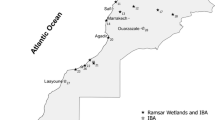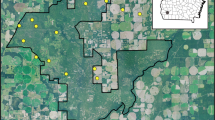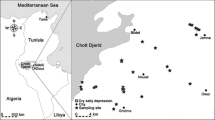Abstract
Wetlands of remote forested landscapes of Quebec support numerous species of breeding waterbirds yet species-habitat associations remain poorly quantified. From 1990 to 2005, we conducted systematic helicopter surveys of breeding waterfowl and common loons (Gavia immer) across a 540,000-km2 forested region of Quebec. Data from this survey were used to investigate local habitat use and selection by waterbirds, based on a wetland classification system derived from digital forestry maps. Detailed indicated-breeding-pair (IBP) distributions were developed for broad aquatic, wetland, and shoreline habitat types. We also estimated selection ratios within groups of similar habitat types. Small (≤8 ha), connected ponds were highly used and selected by five dabbling duck species and by wood duck (Aix sponsa), Canada goose (Branta canadensis), ring-necked duck (Aythya collaris), hooded merganser (Lophodytes cucullatus), common goldeneye (Bucephala clangula), and Barrow’s goldeneye (B. islandica). Dabbling duck species, wood duck, and Canada goose made extensive use of streams (25–41% of all IBP). Community organization was mainly driven by openness of aquatic habitat and water movement, i.e., from lentic to lotic habitats. Failure to include streams in waterfowl surveys and habitat mapping could produce biased estimates of wetland habitat use and selection in the boreal forest.


Similar content being viewed by others
References
Agresti A (1996) An introduction to categorical data analysis. Wiley, New York
Bellrose FC (1976) Ducks, geese & swans of North America, 2nd edn. Stackpole Books, Wildlife Management Institute, Harrisburg
Bordage D (1987) Suivi des couples nicheurs de Canard noir en forêt boréale—1985. Service canadien de la faune, région du Québec. Série de rapports techniques No 18
Bordage D (1988) Suivi des couples nicheurs de Canard noir en forêt boréale—1986. Service canadien de la faune, région du Québec. Série de rapports techniques No 36
Bordage D, Lepage C, Orichefsky S (2003) 2003 Black Duck Joint Venture helicopter survey—Québec. Canadian Wildlife Service, Québec Region. Available at http://www.qc.ec.gc.ca/faune/faune/pdf/PCCN2003_EN.pdf. Accessed 15 Oct 2009
Brown MK, Parsons GR (1979) Waterfowl production on beaver flowages in a part of northern New York. New York Fish and Game Journal 26:142–153
Brown DJ, Hubert WA, Anderson SH (1996) Beaver ponds create wetland habitat for birds in mountains of southeastern Wyoming. Wetlands 16:127–133
COSEWIC (2007) Canadian Species at Risk. Committee on the Status of Endangered Wildlife in Canada
Cowardin LM, Carter V, Golet FC, LaRoe ET (1979) Classification of wetlands and deepwater habitats of the United States. Fish and Wildlife Service, FWS/OBS-79/31, Washington, DC
DesGranges JL, Darveau M (1985) Effect of lake acidity and morphometry on the distribution of aquatic birds in southern Quebec. Holarctic Ecology 8:181–190
Dwyer CP, Baldassarre GA (1994) Habitat use by sympatric female mallards and American black ducks breeding in a forested environment. Canadian Journal of Zoology 72:1538–1542
Dzubin A (1969) Assessing breeding populations of ducks by ground counts. In: Proceedings of the 1969 Saskatoon Wetlands Seminar. Canadian Wildlife Service Report Series 6:178–237
Elmberg J, Nummi P, Pöysä H, Sjöberg K (2003) Breeding success of sympatric dabbling ducks in relation to population density and food resources. Oikos 100:333–341
Environmental Systems Research Institute, Inc (2005) ArcGIS 9.1. Environmental Systems Research Institute, Inc, Redlands
Gabor TS, Murkin HR, Ingram JW (2002) Waterfowl use of managed and unmanaged beaver ponds in south-central Ontario. Northeast Wildlife 57
Gauthier J, Aubry Y (eds) (1995) Atlas of the breeding birds of Southern Québec. Association québécoise des groupes d'ornithologues, Province of Quebec Society for the Protection of Birds, Canadian Wildlife Service, Environment Canada, Quebec Region, Montréal
Gauthier G, Smith JNM (1987) Territorial behaviour, nest-site availability, and breeding density in buffleheads. The Journal of Animal Ecology 56:171–184
Haapanen A, Nilsson L (1979) Breeding waterfowl populations in northern Fennoscandia. Ornis Scandinavica 10:145–219
Lafond R, Pilon C (2004) Abondance du castor (Castor canadensis) au Québec—Bilan d'un programme d'inventaire aérien. Le Naturaliste Canadien 128:43–51
Legendre P, Legendre L (1998) Numerical Ecology, 2nd edn. Elsevier, The Netherlands
Leibowitz SG (2003) Isolated wetlands and their functions: an ecological perspective. Wetlands 23:517–531
Létourneau JP (1999) Norme de cartographie écoforestière—Confection et mise à jour—Troisième programme de la connaissance de la ressource forestière. Direction des inventaires forestiers, Forêt Québec, Ministère des Ressources naturelles
Longcore JR, McAuley DG, Hepp GR, Rhymer JM (2000) American black duck (Anas rubripes). In: Poole A, Gill F (eds) The birds of North America. The Birds of North America, Inc., Philadelphia
Longcore JR, McAuley DG, Pendleton GW, Reid Bennatti C, Mingo TM, Stromborg KL (2006) Macroinvertebrate abundance, water chemistry, and wetland characteristics affect use of wetlands by avian species in Maine. Hydrobiologia 567:143–167
Mallory ML, Blancher PJ, Weatherhead PJ, McNicol DK (1994) Presence or absence of fish as a cue to macroinvertebrate abundance in boreal wetlands. Hydrobiologia 279(280):345–351
Manly BFJ, McDonald LL, Thomas DL, McDonald TL, Erickson WP (2002) Resource selection by animals: statistical design and analysis for field studies, 2nd edn. Kluwer, USA
Marklund O, Sandsten H, Hansson LA, Blindow I (2002) Effects of waterfowl and fish on submergent vegetation and macroinvertebrates. Freshwater Biology 47:2049–2059
McCall TC, Hodgman TP, Diefenbach DR, Owen RBJr (1996) Beaver populations and their relation to wetland habitat and breeding waterfowl in Maine. Wetlands 16:163–172
McNicol DK, Bendell BE, Ross RK (1987) Studies of the effects of acidification on aquatic wildlife in Canada: waterfowl and trophic relationships in small lakes in northern Ontario. Canadian Wildlife Service, Occasional Paper no, 62
Ménard S, Darveau M, Imbeau L (2006) Forest inventory maps: a useful tool for a wetland habitat classification and regionalization in Quebec's forests. In: Proceedings of the 2006 Eastern CANUSA Conference. Natural Resources Canada—Canadian Forest Service, Ministère des Ressources naturelles et de la Faune du Québec—Direction de la recherche forestière, and Université Laval—Faculté de foresterie et de géomatique, Québec, Québec, Canada, pp 105–110
MRNQ (1999) Base de données topographiques du Québec (BDTQ) à l'échelle 1/20 000—Normes de production, version 1.0. Ministère des Ressources naturelles du Québec
Neu CW, Byers CR, Peek JM (1974) A technique for analysis of utilization-availability data. The Journal of Wildlife Management 38:541–545
Nummi P, Pöysä H (1995) Breeding success of ducks in relation to different habitat factors. Ibis 137:145–150
Nummi P, Pöysä H (1997) Population and community level responses in Anas-species to patch disturbance caused by an ecosystem engineer, the beaver. Ecography 20:580–584
Nummi P, Pöysä H, Elmberg J, Sjöberg K (1994) Habitat distribution of the mallard in relation to vegetation structure, food, and population density. Hydrobiologia 279(280):247–252
Ozesmi SL, Bauer ME (2002) Satellite remote sensing of wetlands. Wetlands Ecology and Management 10:381–402
Paquette GA, Ankney CD (1996) Wetland selection by American green-winged teal breeding in British Columbia. The Condor 98:27–33
Poole A (ed.) (2008) The Birds of North America Online. Cornell Laboratory of Ornithology, Ithaca, NY. Available at http://bna.birds.cornell.edu/bna. Accessed 15 Oct 2009
Rempel R, Abraham KF, Gadawski TR, Gabor TS, Ross RK (1997) A simple wetland habitat classification for boreal forest waterfowl. The Journal of Wildlife Management 61:746–757
Renouf RN (1972) Waterfowl utilization of beaver ponds in New Brunswick. The Journal of Wildlife Management 36:740–744
Ringelman JK, Longcore JR, RBJr O (1982) Breeding habitat selection and home range of radio-marked black ducks (Anas rubripes) in Maine. Canadian Journal of Zoology 60:241–248
Robert M, Bordage D, Savard JPL, Fitzgerald G, Morneau F (2000) The breeding range of the Barrow's goldeneye in eastern North America. The Wilson Bulletin 112:1–7
Ross RK (1985) Helicopter vs. ground surveys of waterfowl in the boreal forest. Wildlife Society Bulletin 13:153–157
SAS Institute (2002) Version 9.1. SAS Institute, Cary
ter Braak CJF, Smilauer P (2002) Canoco for Windows, Version 4.5. Biometris—Plant Research International, Wageningen
Toft CA, Trauger DL, Murdy HW (1982) Tests for species interactions: breeding phenology and habitat use in subarctic ducks. The American Naturalist 120:586–613
Acknowledgements
Our project was financially supported by the BDJV, the CWS, Ducks Unlimited Canada, the Fondation de l’Université du Québec en Abitibi-Témiscamingue, and the Canadian Boreal Initiative. The Quebec Ministry of Natural Resources and Wildlife provided forestry maps. L. V. Lemelin received a Master’s scholarship from the Natural Sciences and Engineering Research Council of Canada. F. Fournier (CWS), E. Reed (CWS), J. Sedinger (Univ. of Nevada), M. Drever (Univ. of British Columbia), P. Nummi (Univ. of Helsinki), B. Clark (CWS), and anonymous reviewers provided helpful comments on previous versions of this manuscript. We thank the observers and pilots who logged many survey hours in helicopters, and B. Parsons, J. Kirby, and E. Filotas for their help with copy editing.
Author information
Authors and Affiliations
Corresponding author
Rights and permissions
About this article
Cite this article
Lemelin, LV., Darveau, M., Imbeau, L. et al. Wetland Use and Selection by Breeding Waterbirds in the Boreal Forest of Quebec, Canada. Wetlands 30, 321–332 (2010). https://doi.org/10.1007/s13157-010-0024-z
Received:
Accepted:
Published:
Issue Date:
DOI: https://doi.org/10.1007/s13157-010-0024-z




